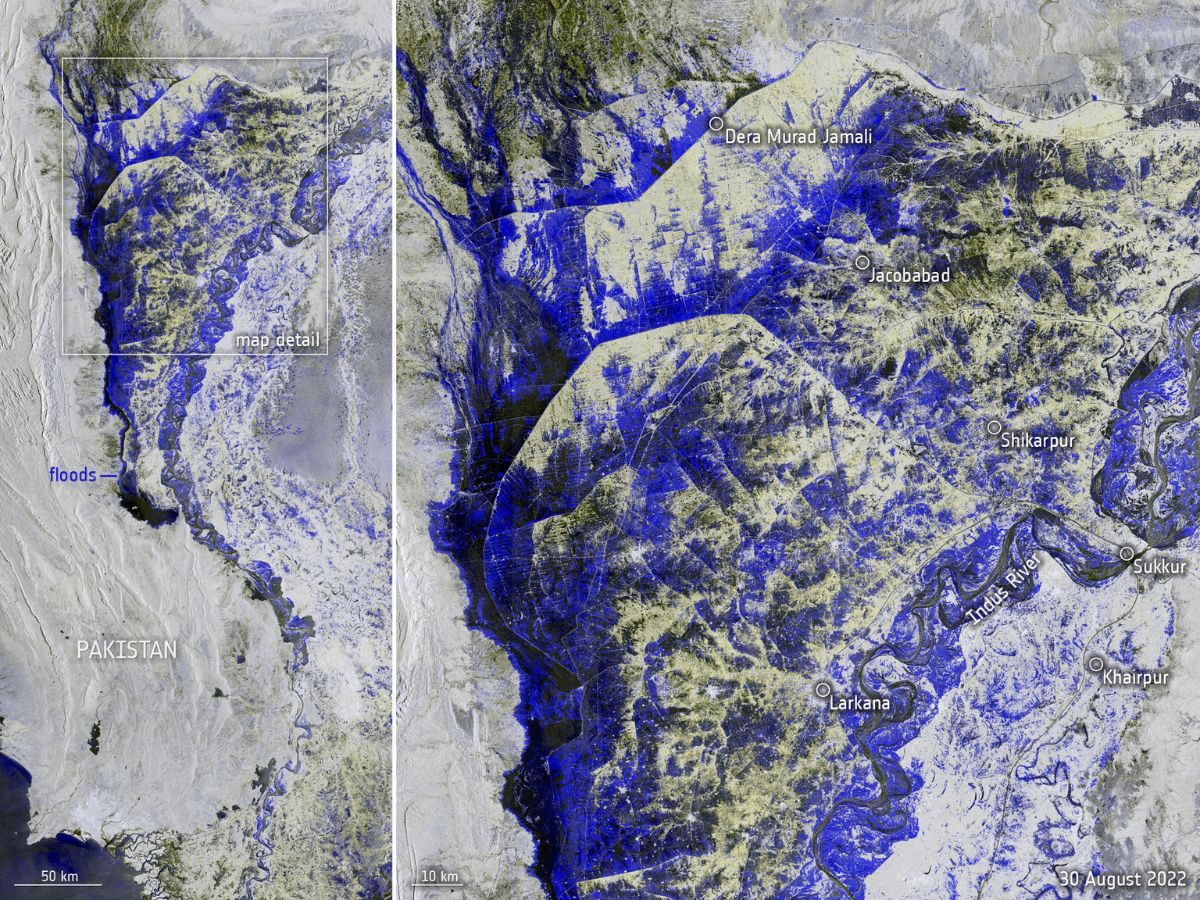The European Space Agency (ESA) and the National Aeronautics and Space Administration (NASA) have released satellite images of flood-hit Pakistan, which show the devastating impact of the deluge on the country.
Since mid-June, Pakistan has been experiencing heavy monsoon rainfall. About ten times heavier than usual, the rainfall has led to more than a third of Pakistan now being underwater, an ESA statement said, citing a Pakistani government official. The catastrophic flood, which has claimed the lives of thousands of people, has also washed away homes, croplands and infrastructure. More than 33 million people, who account for one in seven Pakistanis, have been affected by the devastating floods, according to Pakistan's National Disaster Management Authority. The floods have destroyed more than one million houses.
The extreme monsoon rains have drenched Pakistan, resulting in the country's worst flooding in a decade.
The Prime Minister of Pakistan, Shehbaz Sharif, describes the flood as the worst in the country's history. He has also said that it will cost at least $10 billion to repair damaged infrastructure.
European Space Agency’s Images Of Flooding In Pakistan
On August 30, 2022, ESA's Copernicus Sentinel-1, a two-satellite constellation, captured data from space, which was used to map the extent of the Pakistan floods.
On the left side of the Copernicus Sentinel-1 image, one can see a wide view of the area affected. Meanwhile, the right side of the image released by ESA shows the area between Pakistan's cities, Dera Murad Jamali and Larkana. Due to the incessant rain, the Indus River has overflowed. This effectively created a long lake, tens of kilometres wide. The blue to black colours in the image highlight the regions where the land is submerged.
The European Commission has activated the Copernicus Emergency Management Service to provide flood maps from space. These maps help responders deal with the crisis.
The ESA's Copernicus Sentinel-1 mission is useful for monitoring clouds because it carries a radar instrument that can 'see' through clouds and rain darkness.
NASA's Images Of Flood-Hit Pakistan
NASA's Landsat 8 and Landsat 9 captured false-colour images of the flooding in Pakistan on August 4 and August 28, respectively. The Operational Land Imagers aboard the Landsat 8 and Landsat 9 satellites captured these images. According to NASA Earth Observatory, the images combine shortwave infrared, near-infrared, and red light of certain bands to better distinguish flood waters beyond their natural channels. The flood waters have been represented in deep blue.
The regions where the worst flooding occurred are located along the Indus River in the provinces of Punjab, Khyber, Balochistan, Pakhtunkhwa, and Sindh. So far, the provinces of Balochistan and Sindh have received five to six times their 30-year average rainfall. Most of this rainfall arrived during the summer monsoon rains.
About 150 bridges and 3,500 kilometres of roads across the country have been destroyed, according to humanitarian information portal ReliefWeb. Due to the floods, more than 700,000 livestock and two million acres of crops and orchards have been lost.
The Visible Infrared Imaging Radiometer Suite (VIIRS) on the National Oceanic and Atmospheric Administration's NOAA-20 satellite captured an image of flood-hit regions in Pakistan on August 31, 2022. The image, which shows the extent of flooding in Pakistan, uses a combination of near-infrared and visible light to make it easier to see where rivers are out of their banks and spread across floodplains.
The immense volume of rainwater and meltwater have caused Pakistan's large and highly developed irrigation system to overflow.
On August 31, the Indus River System Authority authorised some releases from dams, according to NASA. This is because the water flowing in threatened to exceed the capacity of several reservoirs.
The deluge has turned plains in the southern reaches of the Indus watershed into seas. NASA has also released detailed images of the districts of Qambar and Shikarpur in Sindh province. From July 1 to August 31, these regions received 500 per cent more rainfall than average.
The continued melting of Pakistan's 7,000 glaciers has exacerbated the effect of the monsoon rains. Pakistan holds the most glacial ice found outside the polar regions.
Due to climate warming and recent heat waves, several glacial-outburst floods occurred. The combined rain and meltwater in the rugged northern part of the country has turned slopes into hill torrents.
The Pakistani government declared a national emergency on August 30. With the United Nations Office for the Coordination of Humanitarian Affairs, the Pakistani government called for international aid for humanitarian relief efforts.
The last time Pakistan faced such dramatic and widespread flooding was in 2010.
ALSO READ | Listen In: A New, Immersive Way To Explore NASA James Webb Space Telescope Images, With Sound


